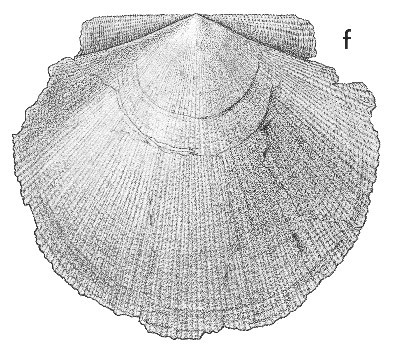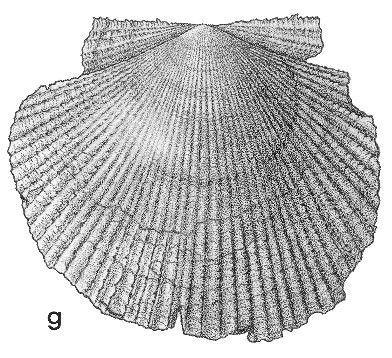
Revised descriptions of New Zealand Cenozoic Mollusca from Beu and Maxwell (1990)

 | Revised descriptions of New Zealand Cenozoic Mollusca from Beu and Maxwell (1990) | 
|
  (Pl. 17f): GS11187, D45/f8824, Lill Sand, Clifden, Lillburnian (GNS) |
  (Pl. 17g): GS11187, D45/f8824, Lill Sand, Clifden, Lillburnian (GNS) |
Beu & Maxwell (1990): Chapter 11; p. 178; pl. 17 f, g.
Synonymy: Pecten yahliensis Tenison Woods 1865, p. 1, fig. 4 A, B; Pecten hutchinsoni Hutton 1873b, p. 31; Pecten beethami Hutton 1873b, p. 31; P. (Patinopecten) hutchinsoni; P. (Patinopecten) beethami; Serripecten beethami; Serripecten hutchinsoni, Beu & Maxwell, 1990, p. 178, pl. 17f, g.; Serripecten yahliensis, Beu & Darragh 2001, p. 83.
Type species (as Pecten hutchinsoni) of Serripecten Marwick, 1928
Classification: Pectinidae
Description: Large for family (length 90-150 mm), longer than high; inequivalve, left valve less inflated than right, disc flattened near dorsal margins. Prominent shell gape at both anterior and posterior ends. Ears very large, growing allometrically, up to 0.67 length of disc in large shells; dorsal margins of right ears divergent, serrated by projecting growth ridges; margins of left valve colinear, smooth. Byssal notch deep in young shells, less prominent in adults, fasciole well marked; no ctenolium. Ears separated from disc by grooves or channels of variable development, typically more prominent on posterior ears. Sculpture on right disc of 38-49 prominent radial costae, rounded or somewhat flattened and nearly smooth at first, then becoming finely scaly and more triangular in section, those towards anterior and posterior margins more assymetrical than in middle. A single, finely scaly costella appearing between each pair of costae at 40-45 mm from umbo, well developed in some shells, scarcely developed in others. Additional costellae appearing in interspaces in some large shells. All secondary and tertiary radials remaining much weaker than primaries. Commarginal sculpture of weak growth ridges only, shell surface having an overall slightly polished appearance. Radial sculpture on left valve commencing as about 26 narrow, rather subdued, almost smooth costellae, becoming much more numerous (through intercalation) and finely scaly during growth, largest shells with as many as 120 narrow costae, most of which are similar in strength. Commarginal sculpture of very fine, low, imbricate lamellae, most of which are not continuous across disc, most prominent on crests of costae where they form small scales. Sculpture on ears similar to that on corresponding disc. Resilifer large, cardinal crura well developed. Adductor muscle scar very large.
Comparison: Serripecten yahliensis is one of the most widely recorded and most characteristic molluscs in the New Zealand mid-Cenozoic and is most common in shallow-water sandstone and shellbeds. It is readily distinguished from other mid-Cenozoic pectens by its large size (exceeded only by Athlopecten athleta), its very large ears, its very wide shape, and its highly discrepant sculpture. Other New Zealand species of Serripecten are much smaller than S. yahliensis and differ in sculptural details, particularly in the number of radial costae on the left valve. Beu & Darragh (2001, p. 83) synonymised the New Zealand species S. hutchinsoni with S. yahliensis, which is based on a neotype selected by Beu & Darragh (2001, p. 83) from Gambier Limestone (Longfordian, Early Miocene) near Mount Gambier, South Australia. The comparison with supposed specimens of S. yahliensis by Beu & Maxwell (1990) was based on the succeeding (Mitchellian-Cheltenhamian, Late Miocene) species in SE Australia, S. carteri Beu & Darragh, 2001, which reaches a significantly larger size and has a still wider shape, longer ears, and much shallower grooves between the ears and the disc than S. yahliensis. We are not aware of records of S. carteri in New Zealand.
Distribution: Duntroonian?, Otaian-Tongaporutuan; Kaipuke Cliffs, Northwest Nelson, Altonian (type locality of P. hutchinsoni); "Upoko Ngaruru" (type locality of P. beethami — i.e., Upokongaruru River, a tributary of Wainuioru River, East Wairarapa, Clifdenian-Waiauan?), and from numerous localities in North and South Islands, in a wide range of lithofacies. The only record as young as Tongaporutuan is from Patutahi Limestone quarry, Gisborne; South Island records are not younger than Waiauan.
Cite this publication as: "A.G. Beu and J.I. Raine (2009). Revised
descriptions of New Zealand Cenozoic Mollusca from Beu and Maxwell (1990). GNS
Science miscellaneous series no. 27."
© GNS Science, 2009
ISBN
978-0-478-19705-1
ISSN 1177-2441
(Included with a PDF facsimile file
copy of New Zealand Geological Survey Paleontological Bulletin 58 in CD version
from: Publications Officer, GNS Science, P.O. Box 30368 Lower Hutt, New
Zealand)